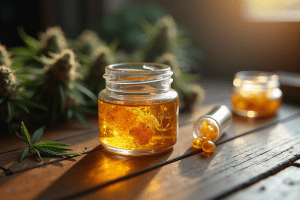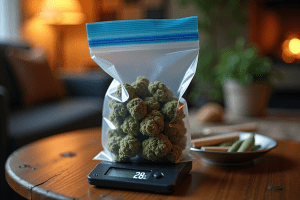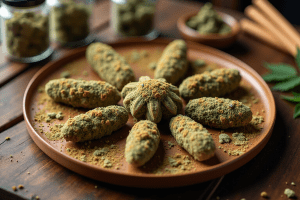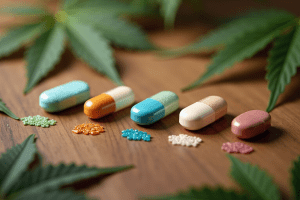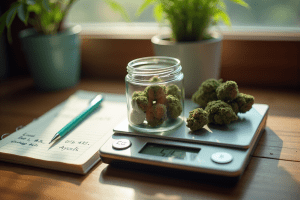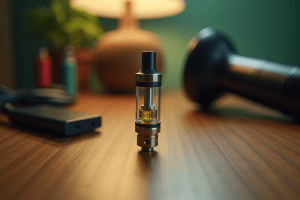Since medical and recreational marijuana legalization has gained momentum, there has been more cannabis plant recalls in the past few years in states like Colorado, California, Michigan, and Florida due to health hazards from smoking moldy marijuana.
Cannabis plants can begin to grow mold in the growing, drying, or curing stages. It becomes more susceptible to decay when the environment is not stable, so it’s crucial to maintain correctly controlled humidity and air ventilation.
Even if buds feel dry, hidden moisture can remain inside. Once sealed in a jar, that moisture can trigger mold growth. To avoid this, let your cannabis dry for an extra day or two before storing.
Too much moisture is dangerous when it comes to the risk of weed mold. As a cannabis consumer, it’s essential to be aware of the potential issues and be able to identify and prevent moldy weed and bud rot.
Cannabis Mold 101
Mold is not suitable for anyone’s immune system, but it may worsen in some individuals. Approximately one-quarter of the human population carries a specific gene that makes them more susceptible to developing mold illnesses.
Others who may be at increased risk for an adverse reaction if they smoke moldy weed include those with asthma, respiratory conditions, autoimmune disorders, chemical sensitivities, and other chronic medical conditions.
Mold contamination isn’t just a health risk—it can also impact the medicinal quality of cannabis. For patients who rely on cannabis for therapeutic relief, even small traces of mold can reduce its effectiveness and make it unsafe to use.
In grow environments, mold spreads quickly. If one plant is affected, nearby crops can also become vulnerable to pathogens and pests. This can lead to widespread contamination, making the harvest unusable and costly to salvage.
That’s why both consumers and growers must prioritize mold prevention—not just to protect health, but to preserve the potency and safety of cannabis used for medication.
Types of Moldy Cannabis
The types of mold that grow on marijuana plants are:
- Powdery Mildew
- Botrytis (Grey Mold)
- Mucor
- Cladosporium
- Rhizopus
- Aspergillus
- Penicillium
Is mold on weed common?
Bud rot and mold are fairly common, especially with home growers due to excess moisture and poor ventilation. Mold is a fungus that thrives in humid environments and reproduces through tiny airborne spores. Improperly drying and curing cannabis—or storing it in a damp or poorly ventilated space—can also trigger mold growth, even if the buds feel dry on the outside.
In cannabis cultivation, poor air circulation plays a critical role in mold proliferation. Without proper ventilation, excess moisture becomes trapped in your grow room, creating conditions that are ripe for mold growth.
To combat this, it’s essential to space your plants adequately. This allows air to flow freely between them, reducing humidity levels. Additionally, investing in a quality ventilation system can be a game-changer. Such systems help maintain optimal airflow and control humidity, preventing mold from taking hold in the first place.
Humans typically inhale or ingest small amounts of mold spores daily, which are not harmful to a healthy immune system. Once your cannabis contains mold spores, it is challenging to get rid of them. They can survive combustion when heated and even the decarb process in an oven.
Ways to Identify Moldy Cannabis
Here are some tips to identify the top six types of cannabis fungal infection so that you can avoid the health consequences of smoking moldy weed.
Bud Rot
Bud rot, also known as botrytis, is a common fungal disease in cannabis—especially for home growers dealing with poor ventilation or excess humidity. This type of mold thrives in warm, damp, and still environments, where it spreads quickly through airborne spores, rain, or wind.
Once botrytis infects a plant, it blocks water and nutrient absorption, which can lead to plant death. Injured or stress-trained plants are particularly vulnerable, even though stress training is often used to boost yield.
To prevent bud rot, keep humidity under control and ensure your grow space has plenty of airflow. If you spot signs of botrytis, remove the affected plant immediately to protect the rest of your crop.
Powdery Mildew
In the early stages of powdery mildew, you can see small circles of white mold on the tops of stems and leaves. As the fungi progress, they will become denser, covering the buds in thick white powder.
Fusarium
Dark spots on the lower leaves will quickly turn the leaves a yellowish-brown color. Visual signs to look out for are leaves that have wilted but not entirely fallen off and droopy stems.
Aspergillus
Common mold is found both indoors and outside. Generally dark green-black, Aspergillus spores create a lung infection after being inhaled and can be found in the soil or cannabis buds.
Penicillium
Penicillium mold is predominantly found indoors. Its spores are typically light blueish-green and can ruin crops and harm humans and animals that have been inhaling mold.
Rhizopus
It produces a grayish-white coating on its spores and may infect humans with certain health conditions, such as when a person has a compromised immune system.
How to Differentiate Between Mold and Trichomes on Cannabis
Telling the difference between mold and trichomes can be difficult for beginners, but there are several ways to distinguish them with a closer inspection.
- Visual appearance: Trichomes look like tiny crystal-like hairs and may appear frosty white or amber. Mold often looks like cobwebs, powdery patches, or fuzzy spots in white, gray, or green shades.
- Texture: Trichomes are sticky and oily to the touch because they hold the plant’s cannabinoids and terpenes. Mold is dry or powdery and can usually be wiped away.
- Location and structure: Trichomes form evenly across buds, giving them a sparkling appearance. Mold appears in irregular clusters, often in the dense inner parts of buds where moisture is trapped.
- Smell: Healthy cannabis with trichomes should smell pungent, sweet, or skunky. Mold has a musty, damp odor that signals spoilage.
Examining the texture, appearance, and scent of cannabis closely can help ensure you’re handling trichome-rich flower—not contaminated buds.
Can smoking moldy weed make you sick?
While smoking moldy weed may not kill you, it is still not recommended and could have potential adverse effects, especially for those with certain chronic conditions.
If you smoke moldy weed and are allergic, you could potentially experience the following mild effects:
- coughing
- nausea and vomiting
But, you could also end up with inflammation of your sinuses and lungs, with more severe symptoms like:
- sinus pain
- drainage
- congestion
- wheezing
- chest pain
Inhaling certain mold species can have severe health consequences for those with weakened immune systems or lung conditions. Some molds like Aspergillus, Mucor, and Cryptococcus can cause severe infections in the lungs, central nervous system, and brain for people with a medical condition related to the immune system.
How to Avoid Moldy Weed
- Buds should be stored properly in a cool, dry place but try not to refrigerate or freeze them. The ideal temperature for flower is just under 77°F.
- Remember to keep your weed in airtight containers, preferably with darker colored glass. Weed does have an expiration date of approximately six months to one year.
- The ideal humidity level in your storage containers should be between 59% to 63%. You can purchase disposable humidity packs at many dispensaries that can be placed inside your mason jar.
- Less airflow can lead to mold, so be sure to provide proper ventilation in the storage room.
- Moldy weed will have a distinct odor. Cannabis products that have been infected by mold will usually smell musty after closer examination. Exposing cannabis to a black light is a good way to see if there’s mold present so you can avoid smoking moldy weed.
Best Practices for Drying and Curing Cannabis to Prevent Mold
To prevent mold, drying and curing cannabis properly is crucial. Start by drying your buds in a well-ventilated space at 60–70°F with humidity between 45–55%. Once dried, transfer them to airtight glass jars, opening them daily for two weeks to release moisture—this is known as the curing process.
For long-term storage, keep the jars sealed in a cool, dark place with humidity levels around 55–62%. You can use humidity packs to maintain this balance. In grow rooms, ensure good airflow and filtration to avoid stagnant air, which promotes mold.
Avoid over-watering during late flowering, as lingering moisture on buds increases the risk of mold. Some growers even diffuse essential oils like thyme or lemongrass to deter mold spores naturally.
How to Prevent Mold on Cannabis Plants
Preventing mold on cannabis plants starts with creating the right environment. After drying and curing properly, store buds in airtight containers and keep humidity under 50% to discourage mold spores. Good airflow and filtration in your grow space are essential to prevent stale, damp conditions.
Avoid over-watering, especially during the flowering phase, and give stress-trained plants a warm, dry space to recover. Some growers use natural antifungals like propolis (bee glue) or organic sprays like bordo mix to help deter mold growth.
You can also diffuse essential oils like thyme, rosemary, or lemongrass to make the air less hospitable for spores. Adding silica to soil strengthens stems and creates a more alkaline environment—less favorable for mold. If you spot any mold, remove affected areas immediately to protect the rest of your crop.
How Essential Oils Can Help Prevent Mold on Cannabis
Essential oils can be a helpful, natural tool to prevent mold on cannabis—especially during storage or in grow rooms. These oils contain antifungal properties that make the environment less welcoming to mold spores.
Here are some essential oils commonly used for mold prevention:
- Thyme Oil: Known for strong antifungal effects that act as a natural mold barrier.
- Rosemary Oil: Deters mold and adds a pleasant herbal scent to the space.
- Eucalyptus Oil: Keeps mold spores in check thanks to its potent antifungal activity.
- Black Caraway Oil: A lesser-known option that also fights mold effectively.
- Lemongrass Oil: Refreshing in scent and protective against mold growth.
You can use these oils in a diffuser to disperse them throughout your storage or grow area. Another option is to lightly mist your space with a water-diluted solution—just be sure not to spray directly on your buds, as it can affect flavor and potency.
Adding essential oils to your routine is a simple, aromatic way to support cannabis preservation and reduce mold risk.
Key Indicators to Consider When Purchasing Cannabis from a Dispensary
To ensure a safe and quality cannabis experience, it’s important to assess the product carefully before buying. Here are key indicators to look for:
- Mold or Mildew: Avoid cannabis with white, gray, or fuzzy patches—these are signs of mold. Healthy buds should have vibrant, natural hues like green, orange, or purple.
- Smell: A musty, damp, or mildew-like odor signals contamination. High-quality cannabis should have a distinct, fresh aroma—citrusy, earthy, piney, or sweet depending on the strain.
- Texture: Buds should feel dense and slightly sticky. If they’re brittle or overly moist, that could indicate poor curing or storage, both of which increase the risk of mold.
- Residue: While trichomes are desirable and appear as crystal-like frost, avoid buds with powdery, dust-like residue that could be mold spores.
- Visual Appeal: Look for well-trimmed buds with a visible coating of trichomes. This indicates cannabinoid and terpene presence, as well as careful cultivation.
By checking for these characteristics, you can make confident decisions at the dispensary and reduce the risk of purchasing compromised cannabis.
What to Do if You Discover Mold on Dispensary-Bought Weed
If you find mold on cannabis you purchased from a dispensary, follow these simple steps:
- Inspect your product closely.
Look for fuzzy spots, discoloration, or a musty smell. Moldy weed is often easy to identify once you know the signs. - Keep the original packaging.
Don’t throw it away—dispensaries usually require the original container for returns or exchanges. - Return to the dispensary.
Bring the product and packaging back. Politely explain the issue. Most dispensaries will offer a refund or replacement to maintain customer satisfaction. - Understand your rights.
Check the dispensary’s return policy and be aware of local cannabis regulations. This knowledge can help you navigate the situation confidently. - Share your feedback.
Let the dispensary know what happened. Your input could help improve their quality control and prevent similar issues for other customers.
What Are the Steps to Safely Dispose of Moldy Weed?
If you find moldy weed, it’s important to dispose of it safely to protect your health and prevent contaminating other cannabis. Follow these steps:
- Keep it away from any growing or cured cannabis to avoid airborne spore spread.
- Seal it in a plastic bag to contain the mold.
- Do not compost it — toss it in the trash bound for landfill.
- Coordinate disposal with trash pickup so it doesn’t linger.
- Clean all tools and surfaces with a strong disinfectant afterward.
- Wear a mask and gloves to avoid inhaling spores.
Moldy weed should never be consumed or reused. Proper disposal ensures your safety and protects future harvests.
Can cannabis be tested for mold?
Yes. There are two standard scientific technologies used to test and identify mold on cannabis plants. Plating-based technologies measure the number of growing mold organisms in a sample.
Scientists can also utilize DNA-based or polymerase chain reaction-based technology to identify the presence of mold DNA from a sample.
Whether you can clean mold off weed depends on the type of mold present.
Can You Clean Mold Off Weed?
Whether you can clean mold off weed depends on the type of mold present.
- Powdery mildew may be wiped from leaves using a damp cloth or paper towel. If it has spread to the buds, the cannabis should be discarded. Moldy buds are unsafe for consumption and can pose health risks.
- Bud rot (botrytis) cannot be cleaned. It spreads internally through the bud and requires full removal of affected flowers to prevent contamination.
- Root rot also cannot be removed. If caught early, you might save the plant by improving drainage and reducing moisture, but extensive root damage usually leads to plant loss.
To prevent mold issues altogether, keep humidity levels in check, provide consistent airflow, and inspect plants frequently for early signs of contamination.
Can weed mold be reversed?
Unfortunately, there’s no reliable way to reverse mold or bud rot once it appears. While you might try removing visible mold from other areas of the plant, there’s no guarantee it hasn’t already spread inside the buds. Mold often grows beyond what you can see, making it unsafe to use any part of the affected flower.
The safest choice is to throw away moldy weed and avoid the health risks. That’s why prevention is key. Store your cannabis in airtight containers, maintain fresh air ventilation, and keep the temperature consistent to reduce the risk of mold growth.
To ensure a mold-free environment for your cannabis while growing, consider these essential steps:
- Regular inspections: Frequently check your plants for any signs of mold. If you spot any affected areas, remove them immediately to prevent spread.
- Ventilation and air circulation: Maintain good airflow in your grow room. This helps prevent the stagnation of humid air, which mold thrives in.
- Temperature and humidity control: Keep a close eye on temperature and humidity levels. Allow your grow space to cool down overnight or when the lights are off to mimic natural conditions.
- Proper drying and storage: Once harvested, properly dry your buds before storing them. Use airtight containers and keep them in a cool, dark, and dry place to maintain quality.
- Monitor storage time: Remember, cannabis can lose quality over time, especially after about six months of storage.
Implementing these practices can significantly reduce the risk of mold, ensuring that your cannabis remains in optimal condition from growth to storage.
How to Identify Mold on Cherry Cheesecake Weed Strain?
When looking to identify mold on a cherry cheesecake weed strain, be on the lookout for fuzzy, discolored spots or a musty smell. Inspect the buds closely for any signs of mold growth, and discard them if you suspect contamination. Proper storage and monitoring can help prevent mold on your cherry cheesecake weed strain.
7 Cannabis Strains that Prevent Mold Spores
If you have ever smoked moldy weed, you understand the importance of avoiding it at all costs when during and after you’ve harvested cannabis.
Below, we’ve included seven of the top mold-resistant strains so your cannabis trichomes can be tasty and mold-free.
Afghan Kush
Afghan Kush is a legendary landrace strain, which means it’s a natural strain grown on Earth before humans got involved in the cultivation process. It’s equal parts THC and CBD, providing a peaceful yet long-lasting high.
This medical cannabis is known for significantly improving muscle spasms and pain associated with the brain and nervous system. As with most landrace strains, it’s well-known marijuana for resisting mold. Throughout time, this particular strain has been perfected to make it better adapted to diverse climate conditions.
Thai Sativa
- OG Kush originated on the West Coast and was first grown in Florida
- It is a popular strain with 18 percent THC and zero CBD content
- It’s a cross between Chemdawg, Lemon Thai, and the Hindu Kush
- OG Kush is a balanced hybrid breed and an excellent strain
- The flavor is sweet citrus, while the aroma is piney with a strong diesel smell.
- It has an average of eight to nine weeks of flowering time indoors
- Its buds are resinous and resistant to mold and mildew
- OG Kush is used in helping treat stress, depression, anxiety, nausea, and appetite loss
- Users say it produces a euphoric, happy high leaving you carefree and hungry
Strawberry Cough
Strawberry Cough has unknown origins. It has 19 percent THC content and one percent CBD. It’s thought to be a combination of Haze and Strawberry Fields and is a potent Sativa strain that naturally resists mold and mildew. It has a skunky aroma and a hint of berry flavor and is one of the best strains to treat mental disorders, anxiety, and depression. The cerebral high provided by this weed will leave you feeling euphoric and energized.
Durban Poison
Durban Poison originated from Durban, South Africa, and is sold by Dutch Passion Seed Company. It has an impressive 19 percent THC and one percent CBD. Durban Poison is a pure Sativa, which makes excellent parent strains. It has an herbal flavor and aroma with hints of pine and sage. This strain has fat buds with many trichomes. Durban Poison is an excellent strain for edibles, promotes creative qualities, and provides better focus than many other strains.
Island Sweet Skunk
- Island Sweet Skunk was first bred at Federation Seed Company in Canada
- It has 18 percent THC and one percent CBD content
- It’s a cross between Skunk No. 1 and Sweet Pink Grapefruit
- It’s a popular classic Sativa strain
- It smells sweet and skunky with a slight grapefruit taste
- The average flowering time indoors is seven to eight weeks long
- It produces a high yield of mold-resistant buds
- It’s used to treat anxiety, inflammation, and muscle spasms
- It produces an uplifting, energetic, and creative high
Super Silver Haze
- Super Silver Haze is bred by Green House Seeds and won first place in the High Times Cannabis Cup several years in the late 1990s
- It has 20 percent THC and 1 percent CBD
- It’s a cross between Haze, Northern Lights, and Skunk
- This marijuana tastes of spicy citrus and smells herbal
- The outdoor flowering time is around 77 days, while indoors is 59 days
- Users say it treats nausea, appetite loss, depression, anxiety, stress, and pain
Blue Dream
- Blue Dream originated in California, on the West Coast
- It has 18 percent THC and low CBD
- It’s a cross of Blueberry and Haze
- Blue Dream is a Sativa dominant hybrid strain
- Flavor and aroma boast sweet berries
- It has an average of 65 days of flowering time
- This strain is used to treat nausea, depression, chronic pain
- Blue Dream produces a relaxing, body-high, and balanced cerebral stimulation
Need More Answers?
Leafy DOC’s healthcare consultants can answer your questions about any cannabis product and its potential benefits and risks. In many states, you can see a doctor online and obtain a medical cannabis card from your own home when convenient for you. Taking this step will help to ensure that your medical marijuana is regulated and safe from mold growth.
Frequently Asked Questions
What are trichomes, and why are they important in cannabis?
Trichomes are tiny, crystal-like glands found mostly on cannabis flowers and leaves. They’re responsible for producing cannabinoids, terpenes, and flavonoids—compounds that influence the plant’s effects, flavor, and aroma. Trichomes also protect the plant from UV rays and pests, and help regulate temperature and moisture.
What is root rot in cannabis, and how can you prevent it?
Root rot is a fungal infection that affects the roots of cannabis plants, often caused by overwatering, poor drainage, or high temperatures. Since it happens underground, signs like browning or wilting leaves are often the first visible symptoms. To prevent root rot, water your plants in moderation, ensure the soil drains well, and keep grow temperatures under control.
Get Your Medical Card
Connect with a licensed physician online in minutes



